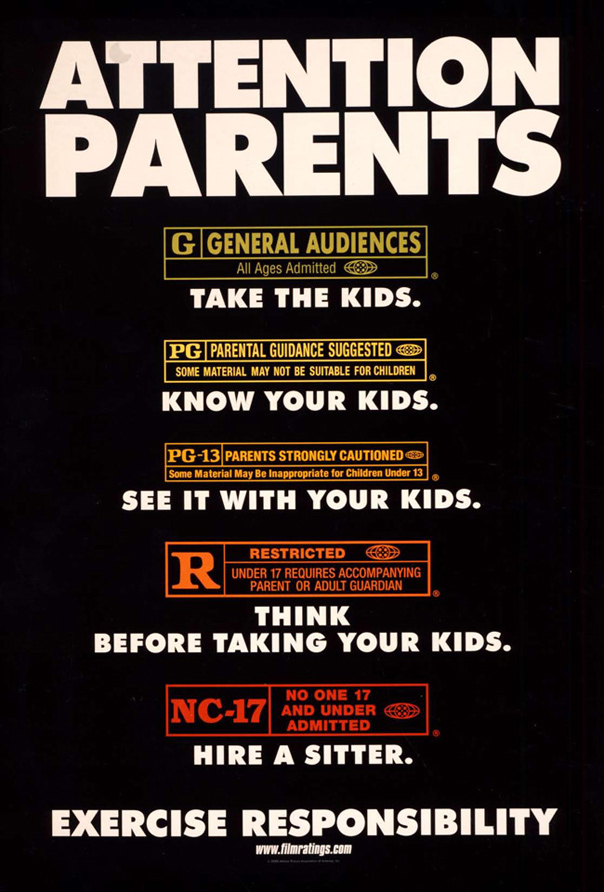If you live in the United States, it is likely that your
television set contains a V-chip, used in accordance with the 2008 Child Safe Viewing Act. These chips, mandated by the Federal Communications Commission (FCC), allow TV users to voluntarily censor their
household from television and movies that earned certain ratings.

Because of an influx of technology plus an increase of violence among children (citing the Desensitizing Theory), film and television ratings have gotten more attention.
This post will compare the United States' rating system (regulated by the Motion Picture Association of America - MPAA) and that of Britain (regulated by the British Board of Film Classification - BBFC). The BBFC and MPAA function as gatekeepers.
Both systems are very similar. And both focus on protecting children, an idea not uncommon in the media industry.
For the sake of brevity, this post will compare BBFC's "18" rating with MPAA's "R" rating.
BBFC's "18"
 |
| BBFC ratings breakdown. |
- No children under 18 can see the film in theaters or buy/rent a copy.
- "Adults are free to pick their entertainment under the law."
- These films may contain:
- Very strong and detailed violence
- Frequent strong language
- Strong portrayals of sexual activity
- Strong horror
- However, these may be cut from the film:
- Material that breaches criminal law
- Material that harms individual morals
- Children under 17 require an accompanying parent or guardian.
- It is "not appropriate for parents to bring their children to an R- rated movie."
- These films may contain:
- Intense or persistent violence
- Hard language
- Sexually-oriented nudity
- It is "not appropriate for parents to bring their children to an R- rated movie."
- These films may contain:
- Intense or persistent violence
- Hard language
- Sexually-oriented nudity
It appears that Britain is more lenient once a child reaches 18, marking them as adults. In the United States, however, R-rated movies are available to 17 year-olds so these films may be less graphic.
It is also interesting to note that the BBFC and MPAA are private media businesses. This injects economics directly into the ratings system and begs the question of objectivity.
Ultimately, ratings lose to the uses and gratification approach. Media users are attracted to the types of content that meet their psychological and social needs, no matter the film rating.
At a basic level, ratings are censorship. Organizations like the BBFC and MPAA examine material and remove parts that are harmful, or rate it "higher" to limit access. However, even in two countries that value freedom of expression, the ratings system provide the benefit of protection, something worth the regulation.
Check out the full sources for more info.
- Sources used in this article:
- "Comfortably Numb" by Brad Bushman and Craig Anderson
- "The V-Chip" by FCC
- U.S. Constitution - Amendment 1
- "Uses and Gratifications Theory in the 21st Century" by Thomas Ruggiero
- Sources for extra information:
- BBFC website
- "Censor" by Merriam-Webster Dictionary
- FCC website
- "MPAA defends its ratings system" by Entertainment Weekly
- MPAA website

"It is also interesting to note that the BBFC and MPAA are private media businesses. This injects economics directly into the ratings system and begs the question of objectivity."
ReplyDeleteThis is very important to understand. Who is really deciding what we should or should not watch? Is that corporation objective?
I am glad that ratings are in place, but I also know that, when I am a parent, I will make the final decisions about what my children watch. Ratings, or, censorship, can't be absolutely trusted when being applied to specific lives and homes because they were not put into place by those lives and homes. We (the people) should be the ultimate raters. We are responsible for what we watch. The media torrent may be overwhelming, but we do have the option to limit it.
This comment has been removed by the author.
ReplyDeleteThe comparison between the two countrys' ratings systems is an interesting note. There seems to be a correlation and, most likely, causation between a country's rating system and their free speech rights and moral values. The U.S. and England share very similar media systems and press rights, along with moral values. However, it would be very interesting to compare and contrast censorship and ratings systems between a country such as the United States and a nation such as Saudi Arabia or Singapore. Both countries have restrictive free speech rights, are very religious, conservative and possess strict moral standards. Consequently, their ratings system would likely contrast that of the United States and England. For each nation, there is a fine line between censoring media for the public good, and unfairly restricting free speech. However, it seems as though the U.S. has employed good judgement, while still allowing for most of the ultimate decisions to be made by us.
ReplyDeleteFrom your analysis of the ratings, it seems as though there is little regulation of content once the user reaches 18 and becomes an adult. While the BBFC's "R18" does limit films for users over 18, the limit seems to be focused on ensuring that the films are shown in appropriate venues, not to stop them from being shown at all. Because of the freedom in regulation once the watcher reaches 18, it seems as though there is little issue regarding freedom of speech from these ratings. When people are adults, the can watch pretty much anything they want. What is interesting is how the establishment of these ratings influences the parental control. By setting the parental control to a certain rating, parents are using the criteria put in place by the BBFC or MPAA as a guideline for appropriate material for children. This puts a lot of power in the hands of these organizations to control who watches what material, which does fall under the issue of censorship and regulation.
ReplyDelete